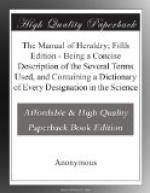In some of the later monumental brasses, the arms on female figures are arranged differently; the arms of the baron appearing on the outside of the mantle, hanging over the dexter shoulder, the paternal arms of the femme on the lining of the mantle turned outwards on the sinister side of the figure.
The reader will find, by referring to the word TOURNAMENT in the Dictionary, that Heraldry formed the great embellishment of that animated and costly amusement: and that the attainment of heraldic honours was the only means of gaining permission to join in it, and by this means only was a passport obtained to high society. These honours, which cost some trouble in gaining, could be lost by misconduct. Arms were forfeited for uncourteous demeanour, disregard of authority, falsehood, oppression, and ungentlemanly conduct; and there can be little doubt but, in a semi-barbarous age, when prowess in the field of battle was considered the highest acomplishment, that the dread of a blot on the escutcheon, or a reversal of the shield of arms, restrained many a proud baron in his tyrannical proceedings to those beneath him, and tended to keep down the insolence of the upstart favourites of royalty. Heraldry tended to soften and polish the manners, and, by the introduction of the manufacture of silken housings tapestry, and carpeting, to increase the comforts and pleasures of society, and compelled those who were anxious to exhibit the insignia of gentility, to seek distinction by other means than rapine and violence.
The term Canting Heraldry frequently occurs in ancient and modern authors. It is a term of contempt and derision, applied to symbolic bearings that are assumed without the authority of the Heralds’ College. In many cases they allude to the name or occupation of the bearer: the motto is probably a pun upon the figures contained in the shield, or some technical expression used by the parties in their agricultural or commercial pursuits.
No person, when heraldry was in its greatest repute, dared assume any cognizance or bearing without permission of the Earl Marshal or the Kings-at-Arms. Any individuals, who presumed, by assumption, to offend the laws of the court of honour, were liable to heavy fines and personal duresse, which in many instances have been rigidly enforced.




